~LAST WEEK to CATCH THE TIPIS !!
. . and other NATIVE AMERICAN ARTIFACTS: as in artist/artisans – & – talk about the glory days of AMERICANA !!
DEDICATED TO DAN CASSARA: THE SVA GRAPHIC DESIGN ‘whizz kid’ CLASS OF a 2008 – who just packed it all up – quit his plum job at MTV (!!) – and headed out cross country to Portland, OREGON, in a mini RV !! – hoping to sell his creative skills as he goes. and yes, if you run across him on his great adventure – you DO want him to to do your restaurant menu, signage, logo, or maybe even ‘stencil’ your walls. ha.
itinerant creative types, not to mention independent & entrepreneurial !! on the move again, just like in the old colonial days, or what !!
this is where it’s at – America 2011. wagon-ho !! even Brooklyn ain’t cool enuff.
and just sayin – but what an RV – if not a tipi ?
Pack it up – and you go, boy. westward, ho. shades of Michelle Williams, or what.
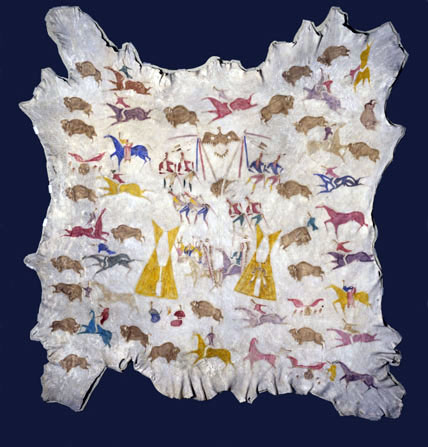
Cadzi Cody (Cotsiogo) (Shoshone, 1866-1912). Painted Robe, circa 1900. Wyoming. Elk hide, pigment, approx 81 x 88 in. BROOKLYN MUSEUM, Dick S. Ramsay Fund, 64:13.
PHOTO COURTESY/BROOKLYN MUSEUM
TIPI: HERITAGE of the GREAT PLAINS
FEB 18 – MAY 15, 2011
MORRIS A. and MEYER SCHAPIRO WING, CANTOR GALLERY, 5th FLOOR
BROOKLYN MUSEUM – 200 EASTERN PARKWAY – BROOKLYN
SUGGESTED CONTRIBUTION: ADULTS $10 / STUDENTS $6 / CHILDREN UNDER 12 FREE
all following texts – from the BROOKLYN MUSEUM WEBSITE:
TIP: HERITAGE of the GREAT PLAINS focuses on the tipi as the center of Plains culture and social, religious, and creative traditions
from the early 19th century to the present . . . TIPI features more than 160 objects from the Brooklyn Museum’s collection of Plains material, as well as selected works from other museums; objects by contemporary Plains artists; and 3 full-size tipis, two with furnished interiors.
The exhibition includes objects from a large number of tribes from the Northern, Central, and Southern Plains. . . it explores the role of women, who were the owners of the tipi and makers of the tipi itself as well as the furnishings, clothing, and accessories kept within it; the traditional role of men as warriors,whose military exploits are depicted on tipi covers and liners; and the tipi as the center of childhood and family life.
In addition to historical and contemporary objects, the exhibition includes photographs of contemporary Plains family and community life and images of contemporary Native American architecture inspired by the tipi form.
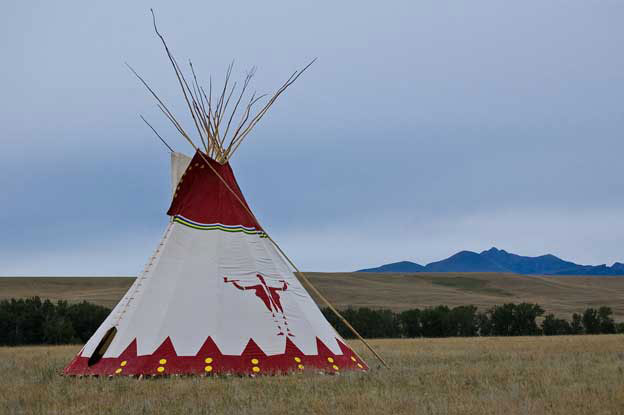
Lyle Heavy Runner (Blackfeet, b. 1958) design owner and painter, Naomi Crawford (Blackfeet, b. 1935), tipi maker. Blackfeet Tipi 2010. Great Falls, Montana. Canvas, latex paint, wood. h. 27 ft. Commissioned for TPI: HERITAGE of the GREAT PLAINS, BROOKLYN MUSEUM, TL2010.89
PHOTO: JENNY STEVEN. PHOTO COURTESY/BROOKLYN MUSEUM
Tipi designs connect their owners with all the other beings in the world as well as with their ancestors, who transfer designs to their descendants in visions. (!!) Design ownership means that a person has the right to pass that design to someone else through ceremony. The Bleeding Skull design (of this tipi above) was given to Blackfeet artist LYLE J. HEAVY RUNNER by his mentor, ROBERT L. ‘RICE’, CRAWFORD, who received it from his grandparents.
Tipi designs are read from the ground up , from earth to sky. The red triangles on the bottom are mountains; the yellow circles are starbursts or falling stars, indicating a lodge containing a medicine bundle ( a sacred bundle containing medicines and other materials that provide power and protection. (!!)
The main design of bleeding skulls can be interpreted as two standing men extending pipes and hatchets. The back of the tipi (not visible in the photo) features a red beaver lodge surmounted by a tree, referencing the fact that Crawford’s parents were holders of the Beaver Medicine Bundle.
The top of the tipi is painted with a rainbow of green (earth) , yellow (sun), and blue (sky), above which is the North Star, and the yellow circles on the ear flaps represent the Big Dipper and the Pleiades.
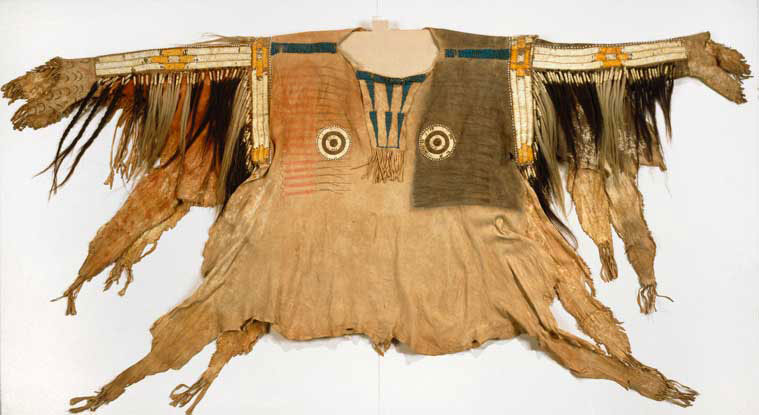
Yanktonai artist. Shirt for Chief’s War Dress, early 19th century, Fort Snelling, Minnesoat. buckskin, pony beads, porcupine quills, buckskin, maidenhair fern stem, human hair, dye, feather, 44 x 68 in. BROOKLYN MUSEUM, HENRY L. BATTERMAN FUND and the FRANK SHERMAN BENSON FUND, 50.67.1a PHOTO COURTESY/BROOKLYN MUSEUM
(YO, human hair ? this shirt carries its own DNA sample. cloners in the future – gonna like that. no doubt !!)
( . . . along with the colonial white people’s souvenir/keepsake – ‘locks of hair’ – snipped & stored in golden lockets).
(damn sharp pre-sentient instincts – or, what !!)
This war shirt with matching leggings was collected by by Dr. Nathan Sturges Jarvis Sr., a military surgeon stationed at Fort Snelling, Minnesota, from 1833 to 1836. The shirt’s painted designs probably represent war exploits: single lines are stylized rifles, bifurcated lines are quirts (riding whips). The horse tracks on the right sleeve indicate successful horse raids.
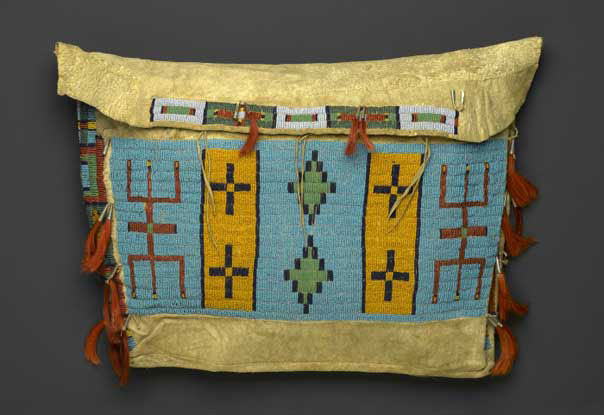
Sioux artist. Storage Bag, late 19th century. Central Plains. Hide, beads, tin cones, horsehair, 15-1/2 x 20-1/2 in. BROOKLYN MUSEUM, BROOKLYN MUSEUM COLLECTION, X1111.1. PHOTO COURTESY/BROOKLYN MUSEUM
During the 18th century, European traders brought glass beads to native tribes living west of the Missouri River. The numerous colors of beads allowed for more creativity, and they supplanted the more subdued and labor-intensive bird and porcupine quills that had been used for decoration. The early white, blue, and black beads were called pony beads because they were transported on ponies. Smaller ‘seed’ beads replaced the pony beads in popularity because of greater availability and color choice.
end text: BROOKLYN MUSEUM.
. . . . . . . . . . .
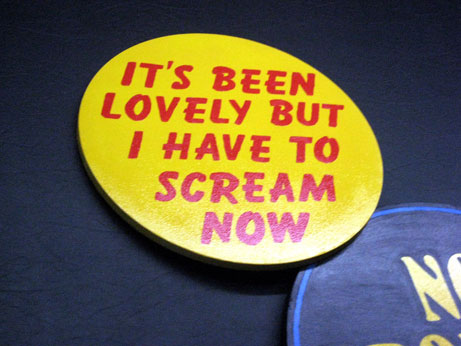
PATRICK GRIFFIN. ‘COUNT THY BUTTONS’. THE JOURNAL GALLERY, BROOKLYN. AUG 14, 2008.
p.s. from the golden oldie vault. what only 3 long years ago ?
here’s some sunny day Monday blues fun – take a trip back in time – & – check out some pix – from the long hot summer of 2008.
it’s got some real gems . . such as ? PATRICK GRIFFIN & his ‘COUNT THY BUTTONS’ show, for starters. still among my top ten faves of all time !!
see: ART LOVERS PHOTOS – SUMMER’S HEAT 2008 !!
